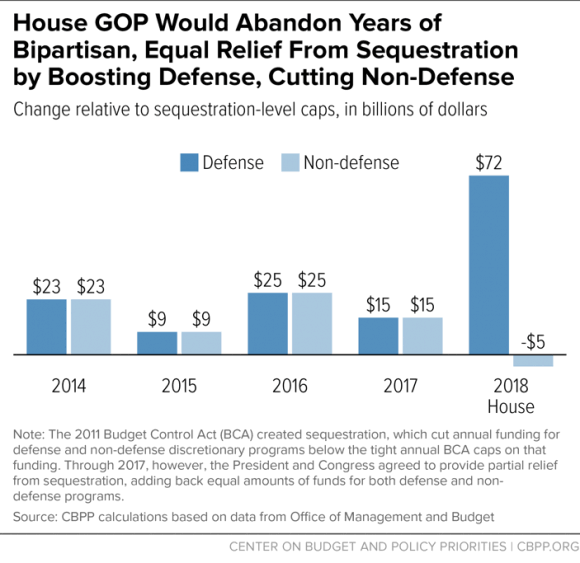BEYOND THE NUMBERS
The House is scheduled this week to take the next step to implement the Republican majority’s 2018 appropriations plan, which pairs a $70 billion increase above the 2017 level for defense with an $8 billion cut to non-defense programs. That unbalanced plan would fall far short of meeting national needs, as we detailed in a recent paper.
Before the August recess, the House Appropriations Committee approved all 12 regular appropriations bills for 2018, and the House passed a package of four of those bills that included essentially all of the defense increase. Now the House is scheduled to consider a second package of the remaining eight measures, which contain most of the non-defense cuts.
These new non-defense cuts would follow seven years of austerity under the 2011 Budget Control Act (BCA) and would bring total non-defense appropriations 17 percent below the comparable 2010 level after adjusting for inflation and 22 percent below 2010 after adjusting for both inflation and population growth.
We’ve illustrated some of the ways in which the committee-approved funding levels reflected in this package of eight bills wouldn’t meet national needs (in these examples, the comparisons between 2017 and 2018 are not adjusted for inflation unless otherwise noted):
- Elementary and secondary education. The legislation would cut appropriations for elementary and secondary education assistance $2.3 billion below the 2017 level, bringing the cumulative inflation-adjusted reduction since 2010 to 20 percent. This year’s proposed cuts include eliminating grants that help recruit, train, support, and retain high-quality teachers and grants for comprehensive family literacy programs.
- Water infrastructure. The legislation would further reduce aid to localities to meet the cost of upgrading and replacing aging drinking water and wastewater treatment infrastructure —with a $270 million cut to funding through the Environmental Protection Agency (a 46 percent cumulative reduction below the 2001 level on an inflation-adjusted basis) and a $98 million (17 percent) cut to Agriculture Department programs geared to the specific needs of rural communities.
- Job training and employment. The legislation would cut the three core formula grants to states and localities to $86 million below the 2017 level, bringing their inflation-adjusted funding 23 percent below the 2010 level and 43 percent below the 2001 level, and would eliminate grants to expand apprenticeship programs. The legislation would also eliminate grants to states for operating the Employment Service, which helps match job seekers to jobs and provides career services in conjunction with, and often before, other related programs.
- Mental health. The Community Mental Health Services Block grant would shrink by one-quarter, from $563 million in 2017 to $421 million in 2018. This block grant helps support essential mental health treatment and related services for people without health insurance, and it fills gaps not covered by sources such as private coverage and Medicaid. It’s an important element in addressing the opioid crisis, given the frequent link between substance use disorders and mental illness.
- Rental assistance. The legislation would defund about 140,000 housing assistance vouchers, as the modest funding increase that it provides falls short of what’s needed to keep up with rising rental costs in the private market. Vouchers play a critical role in reducing homelessness, providing stable housing to low-wage working families, and helping seniors and people with disabilities afford homes that meet their needs, but this assistance now reaches only about 1 in 4 eligible households.
- Internal Revenue Service (IRS). The IRS budget would be cut by another $149 million below the 2017 level, leaving it $2.9 billion or 21 percent below its 2010 level after adjusting for inflation. Funding pressure since 2010 has forced the agency to sharply reduce its workforce and delay long-overdue upgrades to information technology systems, harming customer service, compromising cybersecurity, and undermining efforts to combat tax avoidance and identity theft.
- Family planning. The legislation would eliminate the “Title X” Family Planning program. This program, which began in 1970, makes grants to state and local health departments and non-profit organizations to provide voluntary family planning services to low-income people, along with related services such as pregnancy testing and counseling and screenings for cancer and sexually transmitted diseases.
- Child care. Appropriations for child care assistance, which helps low-income families afford safe child care while the parents are at work, would rise by just 0.1 percent ($4 million) as compared to the 2017 level — considerably less than what’s needed to keep up with rising child care costs, let alone make the improvements in quality and safety mandated by bipartisan legislation enacted in 2014. This and related child care programs now serve considerably fewer children than in 2006 and fewer than 1 in 6 of those eligible.
- Disease control and prevention. The legislation would cut appropriations for the Centers for Disease Control and Prevention (CDC) by $198 million, making cuts in areas such as immunization, control of emerging infectious diseases, and tobacco use reduction. The cumulative reduction in CDC’s budget since 2010, adjusted for inflation, would be 12 percent.
These and other non-defense cuts in the 12 House bills are $5 billion larger than what’s required by the BCA cap on non-defense funding for 2018 — a cap that now reflects the full additional cuts that sequestration requires. In contrast, the House defense levels exceed the BCA defense cap by $72 billion. To pursue a far better course, Congress should come together on a balanced plan that provides equal amounts of sequestration relief for both defense and non-defense programs, as policymakers have done for each previous year since sequestration took effect (see chart).

